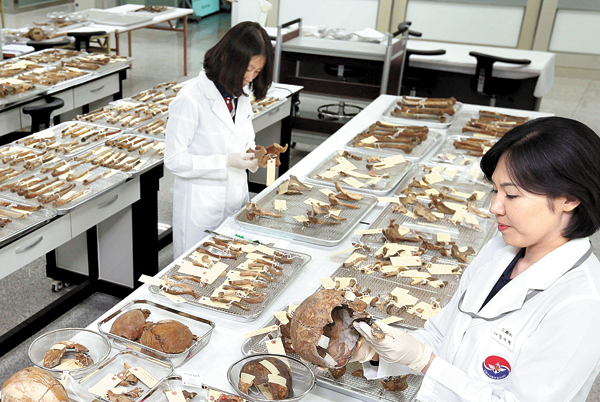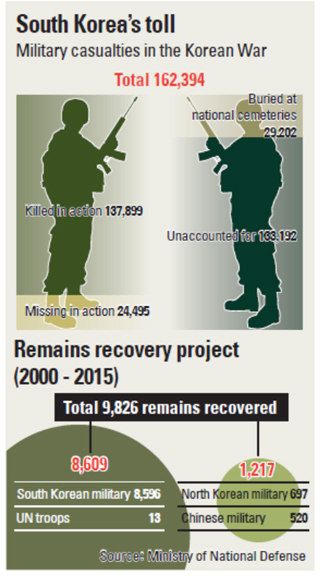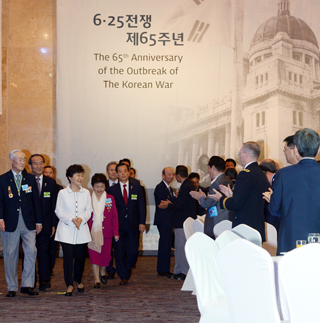Time running out in ‘war’ to find remains

Specialists at the Central Identification Laboratory examine remains on Tuesday.By Kim Seong-ryong
Choi, a member of the 17th Regiment of the Capital Infantry Division, died during a battle in Chilgok, North Gyeongsang, on Aug. 23, 1950. According to Eom, her husband told her in the dream: “If you walk along the mountain road, you can find me.”
Three days later, the Ministry of National Defense informed Eom that Choi’s remains had finally been recovered. It was the first success for the Ministry of National Defense’s Agency for KIA (Killed in Action) Recovery and Identification.
Over the next 15 years, the agency excavated the remains of 9,826 soldiers killed in the Korean War from various parts of South Korea. Among them, 8,596 were South Korean soldiers, while 13 belonged to the United Nations forces. Also discovered were 697 remains of North Korean soldiers and 520 Chinese troops.
The Army started the recovery project in 2000 for the 50th anniversary of the 1950-53 Korean War. At the end of a three-year mandate, the Army decided to continue it as a permanent mission. In 2007, the Ministry of National Defense took it over.
For members of the agency, their battle still continues as the country commemorates the 65th anniversary of the start of the Korean War June 25.
“They sacrificed their lives to save our homeland,” said Col. Lee Hak-ki, commander of the agency. “Finding their remains and returning them to their families is a duty of this country. Until we find the last one, we will do our best.”
According to the ministry, 162,394 soldiers of the Korean military were either killed or went missing in action during the Korean War. Among them, only 29,202 were laid to rest in national cemeteries, while the remains of 133,192 are still unaccounted for.
If the agency manages to excavate 1,000 remains each year, the project will take 130 years to complete. “This is a war against time,” Lee said.

“Because they were either hit by artillery or buried hastily, many parts were lost,” said Dr. Jang Yu-ryang, head of the laboratory.
The agency said it decides on excavation sites based on records of battles and testimonies of Korean War veterans and locals. It takes excavations at an average of 170 sites to recover the remains of a single solider.
After the excavations, the remains are placed in coffins made of a fine wood, which is covered with the national flag. After a ceremony, they are moved to the laboratory for identification.
The remains are cleaned, given a 13-digit identification number and then analyzed, including with a 3-D scanning process.
Some remains are identified by dog tags or dental records or personal items found at the same time, like pens or guns.

President Park Geun-hye attends a party in appreciation of war veterans to mark the 65th anniversary of the outbreak of the Korean War at the Lotte Hotel in central Seoul on Wednesday. [NEWSIS]
For such a database, DNA samples from immediate family members of missing soldiers are a must. But few families have cooperated, even though military hospitals offer free health checkups for relatives who provide samples.
Remains that are identified are buried in the national cemetery after relatives have been informed. Unidentified remains are put in paper boxes and stored in a separate facility at 20 degrees Celsius (68 degrees Fahrenheit) and 40 percent humidity. It is a top secret facility and only a few people know the password to get access.
The military said they treat unidentified remains with the utmost respect. Even putting the boxes on the floor is strictly forbidden. The facility currently houses about 6,300 unidentified remains.
According to the ministry, the agency was modeled after the U.S. Joint POW/MIA (Prisoner of War/Missing in Action) Accounting Command, better known as JPAC.
“The United States and Korea are the only two countries that excavate and identify the remains of the fallen soldiers,” said Lee. “In September, officials from Vietnam will visit us to learn about our technologies.”
“This is a project to find the remains of 130,000 patriots,” said Lee. “Until we find the last one, our war is not over. Because the average age of the people who can tell us what happened on the battlefields is 84, we are working with a sense of desperate determination. We only have five years left.”
BY JEONG YONG-SOO, SER MYO-JA [myoja@joongang.co.kr]










with the Korea JoongAng Daily
To write comments, please log in to one of the accounts.
Standards Board Policy (0/250자)